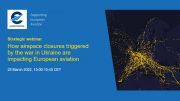The lack of clarity, coordination and guidance to pilots about overflying and flying to Ukraine at times of a developing serious military conflict is a great concern. Despite two disastrous events in the recent past – the MH17 and PS752 – pilots (and airline passengers) were still facing diverging airline decisions, and reliance on the decision-making capabilities of the conflict-stressed state to restrict its airspace. The designated aim of the European States to improve the risk assessment by better information exchange and coordinating the required measures has been unsuccessful.
“A majority of airlines have stopped operating to Ukraine weeks ago, and some have avoided the airspace for years,” says ECA President Otjan de Bruijn. “But others continued to carry out operations until the invasion by Russia started and the airspace was officially closed. Pilots have not forgotten MH17 and PS752 but, I wonder, if CEOs did? Maybe it made sense to continue to fly commercially but from a security and safety point of view it seemed ludicrous to continue.”
Similar inconsistencies have been determined in the past, e.g. in the 2021 Dutch Safety Board on “Safe flight routes”, concluding that “decision on flight prohibition over conflict zones (are) needed sooner”.
For a long time, ECA called for solutions and a harmonized European approach to ensure that timely and equal information of risks related to potential conflict zones would be available to all parties involved. “European States and aviation stakeholders – including pilots – should cooperate under the leadership of a dedicated European body with the goal of sharing the outcome of risk assessments in order to achieve a more transparent and more aligned decision-making process on flight routing by European airlines,” adds de Bruijn. “In this sense, the recently launched EASA Conflict Zones Platform is a step into the right direction, and we are convinced that inclusion of the pilots’ perspective into the Platform’s structures would further enhance its effectiveness.”
“The sad reality is that we have not learned the lessons from MH17 and PS752,” says ECA Director Arik Zipser. “Conflict-stressed states have proven unreliable to timely restrict or close their airspace. Information exchange and risk assessment are sluggish and still a privilege to some airlines, leaving pilots under pressure by the airline: either fly or get out. Purely national, uncoordinated action has not done the job in the past and won’t do it in the future. If nothing substantive occurs through a dedicated European structure to support Member States in a common approach, we will see further flights taking unnecessary risks.”
Key points from ECA’s Position Paper on Flights into And Over Conflict Zones:
Flights over and into conflict zones cause a significant reduction in safety and security and involve the risk of collateral damage. These flights should in principle be avoided and only be conducted after a thorough risk assessment and the implementation of appropriate mitigation measures.
The final responsibility about the conduct of the flight or any change to its routing rests with the Commander and is based on the flight crews’ assessment of information provided by the airline.
As the Commander is responsible for the safety and security of passengers, crew, and the aircraft, his/her decision should never be challenged, e.g., by the open or indirect threat of sanctions and should not be influenced by economic pressure.
To fully support the Commander in his/her responsibility, the airline should pass on all relevant security information in a mandatory, detailed and timely manner.
This applies in particular to short-term changes in risk factors before and during the flight, especially when crews may be in or close to those areas of conflicts.
NOTAMs containing information on flights into and over conflict zones should stand out among the other NOTAMs in order that crews can easily attribute the necessary importance to them.









Be the first to comment on "Flying to and over Ukraine: European response again inconsistent"